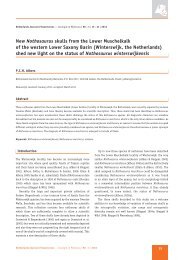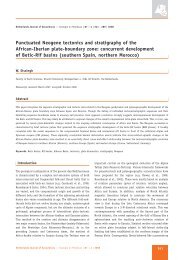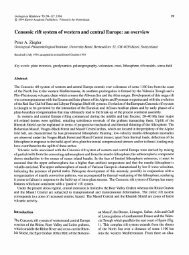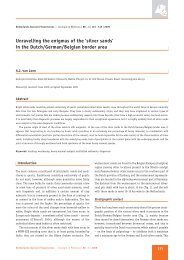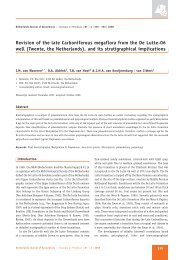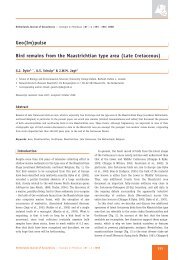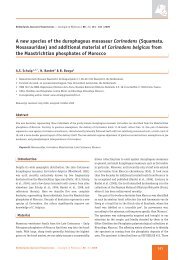Diagnostic sedimentary structures of the fluvial-tidal transition zone ...
Diagnostic sedimentary structures of the fluvial-tidal transition zone ...
Diagnostic sedimentary structures of the fluvial-tidal transition zone ...
Create successful ePaper yourself
Turn your PDF publications into a flip-book with our unique Google optimized e-Paper software.
This leads to <strong>the</strong> question how steeply <strong>the</strong> inclined master<br />
bedding should be to receive <strong>the</strong> IHS qualification. For <strong>the</strong><br />
Hambach channel fills <strong>the</strong> inclination <strong>of</strong> <strong>the</strong> master bedding<br />
goes down to horizontal in <strong>the</strong> centre <strong>of</strong> <strong>the</strong> channels, and<br />
only part <strong>of</strong> it would qualify, though we are dealing with one<br />
type <strong>of</strong> facies. Ano<strong>the</strong>r objection against <strong>the</strong> use <strong>of</strong> IHS is,<br />
that it has not much diagnostic value, because <strong>of</strong> its wide<br />
occurrence. It is not <strong>the</strong> IHS structure as a whole, but <strong>the</strong><br />
<strong>structures</strong> superimposed on it that provide diagnostic clues.<br />
Thomas et al. (1987) listed a series <strong>of</strong> distinguishing characteristics<br />
<strong>of</strong> <strong>the</strong>se superimposed <strong>structures</strong> in <strong>the</strong> <strong>fluvial</strong>-<strong>tidal</strong><br />
<strong>zone</strong>. They mention <strong>the</strong> abundant occurrence <strong>of</strong> (inclined)<br />
linsen and flaser bedding, <strong>the</strong> rhythmic alternation <strong>of</strong> sandmud<br />
interbedding and indications <strong>of</strong> <strong>the</strong> reversal <strong>of</strong> flow, such<br />
as herringbones in x-laminated beds. This is in accordance<br />
with our experience. The IHS structure itself may only be indicative<br />
for accretion on point bars. As such, IHS-units formed<br />
by creeks crossing <strong>tidal</strong> marshes may not exceed a thickness<br />
<strong>of</strong> 2 m, whereas those <strong>of</strong> point bars in <strong>the</strong> <strong>fluvial</strong>-<strong>tidal</strong> <strong>zone</strong><br />
can be an order <strong>of</strong> magnitude larger (Smith, 1987).<br />
Our observation <strong>of</strong> <strong>the</strong> sedimentology <strong>of</strong> <strong>the</strong> <strong>fluvial</strong>-<strong>tidal</strong><br />
<strong>zone</strong> is restricted to a ra<strong>the</strong>r narrow spectrum <strong>of</strong> boundary<br />
conditions <strong>of</strong> meso<strong>tidal</strong> estuaries and medium large rivers in<br />
<strong>the</strong> temperate climatic <strong>zone</strong>. However, <strong>the</strong> diagnostic features<br />
can be explained from hydraulic conditions that are not<br />
unique to <strong>the</strong> restricted set <strong>of</strong> examples presented in this<br />
paper. Therefore, we suppose that our criteria have a ra<strong>the</strong>r<br />
generic value. Unfortunately, this conclusion cannot be decisive,<br />
as detailed description <strong>of</strong> deposits that with certainty were<br />
generated in o<strong>the</strong>r types <strong>of</strong> <strong>fluvial</strong>-<strong>tidal</strong> <strong>transition</strong>s is lacking.<br />
The recognition <strong>of</strong> <strong>the</strong> <strong>fluvial</strong>-<strong>tidal</strong> <strong>zone</strong> from <strong>sedimentary</strong><br />
<strong>structures</strong> would be simple, if all diagnostic <strong>structures</strong> would<br />
be found toge<strong>the</strong>r in a small outcrop. Unfortunately this is<br />
not to be expected, as <strong>the</strong> distinguishing <strong>structures</strong> are not<br />
spread equally along <strong>the</strong> <strong>fluvial</strong>-<strong>tidal</strong> <strong>zone</strong> (see Table 1). For<br />
instance, <strong>the</strong> lateral recurrence <strong>of</strong> pause planes and varying<br />
angles <strong>of</strong> dune cross bedding associated with <strong>the</strong>m seems to<br />
be <strong>of</strong> preferent occurrence in <strong>the</strong> higher parts <strong>of</strong> <strong>the</strong> <strong>fluvial</strong><br />
fining-upward succession. The reason is that in <strong>the</strong> upper<br />
point bar, stage variations make <strong>the</strong>mselves more strongly felt<br />
and cause resident dunes to move and halt intermittently. In<br />
fact, irregular foresetting is <strong>the</strong> first sign in <strong>fluvial</strong> deposits<br />
that announces tides in <strong>the</strong> most upstream part <strong>of</strong> <strong>the</strong> <strong>fluvial</strong><strong>tidal</strong><br />
<strong>zone</strong>. Conversely, <strong>the</strong> upstream (flood) directed single<br />
clay-draped X-bedding, contained in <strong>the</strong> overall <strong>fluvial</strong> Xbedded<br />
interval belongs to <strong>the</strong> spectrum <strong>of</strong> <strong>structures</strong> <strong>of</strong> <strong>the</strong><br />
downstream part <strong>of</strong> <strong>the</strong> <strong>fluvial</strong>-<strong>tidal</strong> <strong>zone</strong>. Bidirectional<br />
heterolitic beds with <strong>the</strong> preservation <strong>of</strong> swollen ripple form<br />
sets drowning into thick clay drapes as shown in photo C and<br />
D, when only present in one <strong>of</strong> <strong>the</strong> two directions, may be <strong>the</strong><br />
most obvious diagnostic feature <strong>of</strong> <strong>the</strong> <strong>fluvial</strong>-<strong>tidal</strong> <strong>zone</strong> in its<br />
most downstream part.<br />
304<br />
Acknowledgements<br />
We thank Bob Dalrymple and Rik Donselaar for <strong>the</strong>ir constructive<br />
comments on <strong>the</strong> manuscript.<br />
References<br />
Allen, G.P., 1991. Sedimentary processes and facies in <strong>the</strong> Gironde estuary: a<br />
recent model for macro<strong>tidal</strong> estuarine systems. In: Smith, D.G., Reinson, G.E.,<br />
Zaitlin, B.A. & Rahmani, R.A. (eds): Clastic Tidal Sedimentology: Canadian<br />
Society <strong>of</strong> Petroleum Geologists Memoir 16: 29-40.<br />
Allen, G.P. & Posamentier, H.W., 1993. Sequence stratigraphy and facies model<br />
<strong>of</strong> an incised valley fill: <strong>the</strong> Gironde estuary, France. Journal <strong>of</strong> Sedimentary<br />
Petrology 63: 378-391.<br />
Allen, J.R.L., 1965. A review <strong>of</strong> <strong>the</strong> origin and characteristics <strong>of</strong> recent alluvial<br />
sediments. Sedimentology 5: 89-191.<br />
Berendsen, H.J.A. & Stouthamer, E., 2001. Palaeogeographical development <strong>of</strong><br />
<strong>the</strong> Rhine-Meuse delta, <strong>the</strong> Ne<strong>the</strong>rlands. Van Gorkum, Assen, <strong>the</strong> Ne<strong>the</strong>rlands:<br />
268 pp.<br />
Bridge, J.S. & Best, J.L., 1988. Flow, sediment transport and bedform dynamics<br />
over <strong>the</strong> <strong>transition</strong> from dunes to upper-stage plane beds: implications from<br />
<strong>the</strong> formation <strong>of</strong> planar laminae. Sedimentology, 35: 753-763.<br />
Boersma, J.R., 1967. Remarkable types <strong>of</strong> mega cross-stratification in <strong>the</strong><br />
fluviatile sequence <strong>of</strong> a recent distributary <strong>of</strong> <strong>the</strong> Rhine, Amerongen, <strong>the</strong><br />
Ne<strong>the</strong>rlands. Geologie en Mijnbouw 46: 217-235.<br />
Boersma, J.R. & Terwindt, J.H.J., 1981. Neap-spring tide sequences <strong>of</strong> inter<strong>tidal</strong><br />
shoal deposits in a meso<strong>tidal</strong> estuary. Sedimentology 28: 151-170.<br />
Brenon, I. & Le Hir, P., 1999. Modelling <strong>the</strong> turbidity maximum in <strong>the</strong> Seine<br />
estuary (France): identification <strong>of</strong> formation processes. Estuarine, Coastal<br />
and Shelf Science 49: 525-544.<br />
Brooks, G.R., 2003. Alluvial deposits <strong>of</strong> a mud-dominated stream: Red River,<br />
Manitoba, Canada. Sedimentology 50: 441-458.<br />
Clifton, H.E., 1994. Preservation <strong>of</strong> transgressive and highstand lat Pleistocene<br />
valley-fill/estuary deposits, Willapa Bay, Washington. In: Dalrymple, R.W.,<br />
Boyd, R. & Zaitlin (eds): Incised valley systems: origin and <strong>sedimentary</strong><br />
sequences. SEPM Special Publication 51: 321-333.<br />
Collinson, J.D. & Lewin, J. (eds), 1983. Modern and Ancient Fluvial Systems.<br />
IAS Special Publication 6: 575 pp.<br />
Cuevas Gozalo, M., 1985. Geometry and lith<strong>of</strong>acies <strong>of</strong> sediment bodies in a<br />
<strong>tidal</strong>ly influenced alluvial area. Middle Eocene, Sou<strong>the</strong>rn Pyrenees, Spain.<br />
Geologie en Mijnbouw 64: 221-231.<br />
Dalrymple, R.W., Makino, Y. & Zaitlin, B.A., 1991. Temporal and spatial patterns<br />
<strong>of</strong> rhythmite deposition on mud flats in <strong>the</strong> macro<strong>tidal</strong> Cobequid Bay –<br />
Salmon River estuary, Bay <strong>of</strong> Fundy, Canada. In: Smith, D.G, Reinson, G.E.,<br />
Zaitlin, B.A. & Rahmani, R.A. (eds): Clastic Tidal Sedimentology: Canadian<br />
Society <strong>of</strong> Petroleum Geologists Memoir 16: 137-160.<br />
Dalrymple, R.W., Zaitlin, B.A. & Boyd, R., 1992. Estuarine facies models:<br />
Conceptual basis and stratigraphic implications. Journal <strong>of</strong> Sedimentary<br />
Petrology 62: 1130-1146.<br />
Ne<strong>the</strong>rlands Journal <strong>of</strong> Geosciences — Geologie en Mijnbouw | 86 – 3 | 2007



